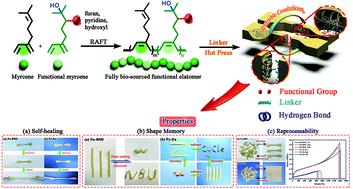Reversible addition–fragmentation chain transfer polymerization of myrcene derivatives: an efficient access to fully bio-sourced functional elastomers with recyclable, shape memory and self-healing properties†
Abstract
The rubber industry has been faced with critical challenges including unsustainable fossil-based monomer sources, lack of functionality and growing environmental concerns of waste vulcanizates. The development of bio-sourced functional polydienes seems to be a promising choice for simultaneous reinforcement, functionalization and reclamation of rubber. In this contribution, functional monomers bearing hydroxyl (My-OH and My-(OH)2), epoxide (My-EPO), furan/hydroxyl (My-Fu-OH) and pyridine/hydroxyl (My-Py-OH) functionalities are employed for reversible addition–fragmentation chain transfer (RAFT) polymerization, affording a series of functional elastomers with a controlled molecular weight and narrow distribution including poly(My-OH), poly(My-OH)2, poly(My-EPO), poly(My-Fu-OH) and poly(My-Py-OH). The polymerization kinetics, selectivity and molecular weight of the polymers are influenced by the functionality which significantly reduces the contact angle against a water droplet. These mean that the interfacial compatibility of rubber and fillers is promoted and the mechanical properties of the polymer blend are enhanced. In addition, thermo-reversible crosslinked elastomers have been fabricated from pyridine and furan functionalized copolymers with zinc acetate or maleimide as a curing agent, respectively. This dynamic feature allows us to harness a type of damage healing, shape memory and reprocessable elastomer with combined merits of thermosets and thermoplastics. The developed sustainable functional polydienes would be interesting as advanced elastomers in the rubber industry.



 Please wait while we load your content...
Please wait while we load your content...